| |
|
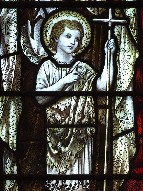 |
|
Few parish
churches have been so effectively
squeezed out of existence as St Mary. But
here, in the endless western suburbs of
Felixstowe, it was clearly the least
sustainable of all the eight Anglican
parish churches in the urban area.
Changing patterns of worship are even
more fickle than those of population, and
in this most evangelical of all Suffolk
towns, worshippers have been pulled in by
the excitement of the Cavendish Community
Church a mile or so away (now born again
as Christ Church). There is also the
glamour of the central Felixstowe
churches; Suffolk's flagship
Anglo-catholic experience at St John the
Baptist, and the rugged protestantism of
St Andrew. St
Mary's main problem is that it sits in
the same churchyard as its neighbour St Martin - or, more accurately, in
adjacent churchyards with the dividing
wall now gone. Any potential congregation
was similarly divided, and so in the
1980s St Mary was effectively closed, St Martin becoming the parish church,
and this one a multi-purpose community
building, a recreational space with
facilities for playgroups and the like.St
Mary was never formally declared
redundant, and is still techinally one of
two churches in a joint parish. However,
in recent years it has been kept pretty
well permanently locked.
|
I got into terrible trouble
once for saying that this was quite the ugliest
church tower I knew, with all the glamour of an
electricity substation, but it has had its
rendering renewed in recent years, and looks
rather spick and span after all. And the nave and
chancel against it is pleasant enough, and
clearly loved. Much survives that is apparently
14th century, but this church, like neighbouring
Walton, was a complete ruin by the 19th century,
and so what we see is essentially a Victorian
rebuilding.
I pass this building on a
fairly regular basis, and as is the way with
these things I had put off trying to get inside
to take any photographs for years, concentrating
my mind on more remote but more accessible
quarries. Adjacent St
Martin is also
always locked without a keyholder, and so is
nearby Walton church, and generally this is not a
part of the world which is particularly friendly
to church visitors. However, I was out cycling
this way with a friend in the late autumn of
2008, and I was intrigued to see a large sign
outside saying Church Open: Model Railway
Exhibition. We hauled our bikes up the path,
and went inside. A table had been set out the
length of the nave with model railway layouts on
it, and several men were standing behind
studiously pressing buttons and flicking
switches. It was a little bizarre, although not
as odd as the Ipswich town centre church of St
Peter, which was filled with model railway
layouts for more than ten years in the 1980s and
1990s. I asked one of the men if I could take
some photographs of the windows. He said yes, and
without further thought I started pottering
about.
I suppose I had been in the
process of photographing for about twenty
seconds, when suddenly a rather short and angry
man came and stood in front of me. "Who are
you, and what are you doing?" he demanded.
Now, knowing my rights, as they say, and having
asked for and received permission, I wasn't about
to crumble. I asked him who he was, and
why he wanted to know.
Raising the pitch and
volume of his voice, he took a step towards me.
"I am the churchwarden! Now, who are you,
and what are you doing?"
Well, that seemed
reasonable enough. I introduced myself, and
explained my project. I have to admit that, while
preserving an outer impression of sang-froid,
I had been rather shaken by his aggressive
attitude, but I was aware that this might well be
the only opportunity I got to photograph the
windows. He in turn seemed to regret being quite
so forceful, and soon he was going out of his way
to be helpful, moving boxes and even offering to
put the lights on. Perhaps it was just as well he
didn't know I'd once commented on how ugly his
church tower was.
What I hadn't known, and
what made the whole traumatic experience
worthwhile, is what a super collection of late
19th and 20th Century stained glass this church
has. The best is the fabulous east window with
Christ the King flanked by censing angels. It
looks as if it should be by Powell & Son,
although Sam Mortlock observes that the maker has
not been identified. Similary, several figures in
the nave are very like the work of Kempe &
Co, but without the familiar wheatsheaf signature
and tablet. Best of all, I liked the memorial
windows to the locally famous Cobbold family,
which depict two of their number as St Edmund and
St George - Mortlock gleefully noted the
incongruity of their walrus moustaches.
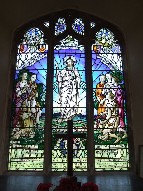 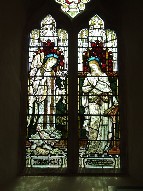 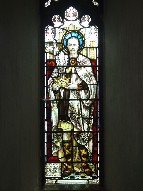 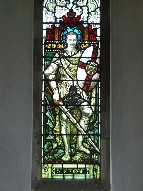 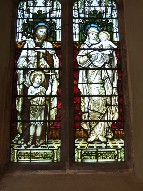 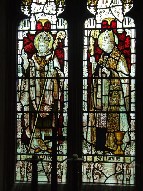
The
chancel is screened off from the rest of the
church by a large curtain. It has rather a
disused feel, but it could probably be restored
to some kind of liturgical use fairly easily. The
last time I had been inside this church, some ten
years previously, I had found it used to store
junk, but this has all gone now.
| The churchwarden
and I were now getting on splendidly, and
I ventured a query as to how I might get
to see inside St Martin next door. As I'd hoped, he
not only had a key with him, but offered
to come and open up. As is the way in a
large suburb like this, St Martin is in regular use for
weddings, and there was one scheduled for
that afternoon, but we might just go and
take a look. I
had one last wondering gaze around St
Mary - who knows how long it might be
before I saw inside again? - and we set
off the short journey of thirty metres or
so to the church on the other side of the
graveyard, wondering what treasures might
await us there.
|
|
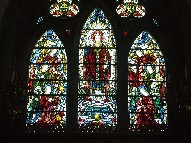 |
|
|
|

